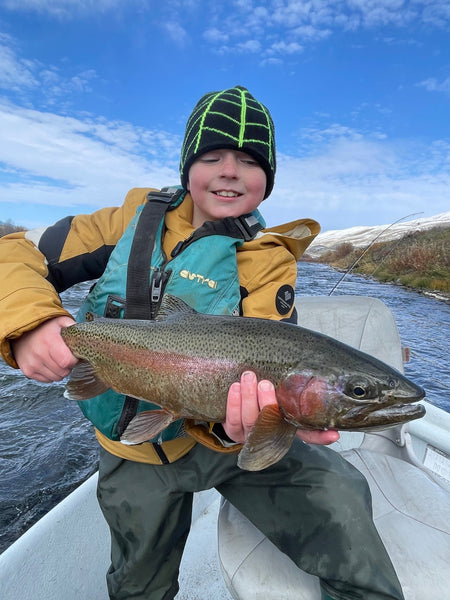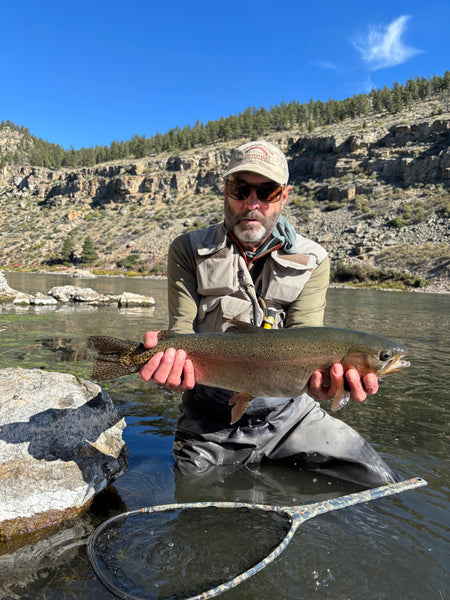Wind and Fly Fishing
Wind and Fly Fishing

No one likes fishing in the wind. Unfortunately, the wind is a fact of life fishing out West. If you are out here on vacation you may be forced to fish in windy conditions a lot of your trip. Making your trip a success often means dealing with wind. Here are several tips to help you along.
Mindset. It starts to blow, you get a tangle or two and it goes downhill quickly. Your mindset goes from having fun straight to frustration. Time to regroup. It is best to go into the day of fishing with the view of just making the best of it. Yes, the wind will decrease your effectiveness, but you can still catch fish, even in the windiest conditions. Accept it, and prepare yourself mentally that conditions will not be easy and you can just power through. You can sit in the bar and pout, or you can go catch some fish. Know it isn’t going to be easy.
Look on the bright side when it comes to wind. It can at times make for better fishing. It does push bugs during a hatch and can make for concentrations of rising fish. Downwind bubble lines get filled tons of bugs. The wind certainly does blow hoppers into the water. Last summer all of my best hopper bites were on windy afternoons. Even when nymphing, an upstream wind helps out, making mends a breeze. Lastly, if the wind is bothering you, it sure is bothering the other anglers on the water. I don’t know how many times I’ve been fishing in solitude because the other anglers quit fishing due to the wind. If you can manage the conditions, you can have a lot of water for yourself.
Method. Let the wind play a roll in deciding how you are going to fish. Rather than fight a breeze, pick a method of fishing that allows you to work with it. In a huge downstream wind, don’t try to nymph or throw dries up the bank. Turn around and fish downstream with wet flies or a streamer. Upstream winds make it easy to indicator nymph but make it very tough to control a drift Euro Nymphing. So don’t make your life harder than it needs to be, put on an indicator. Adjust how you are fishing so you are working with the wind instead of against it.
When fishing dry flies, during a downstream wind work down and across and let the wind reach cast for you. In an upstream wind, fish up the banks straight upstream.
When the wind really blows, Spey fishing is a great solution provided you can cast effectively off both shoulders. Skagit lines cut through the wind easily make delivering the fly normal fishing distances a lot less tiring than fishing a normal single hand set up.
We run into problems when conditions force us fish one way but the wind just won’t allow it. Last October I was guiding on the Firehole on a cold and windy day. Predictably Baetis emerged in great numbers mid-afternoon and the wind pushed a ton of insects into one particular bubble line. Over twenty trout were rising in a small triangle between the bubble line and the bank. The only way to present a dry to them was cast from the bank upstream into the wind. We tried for about 15 minutes to make it work, but couldn’t get the fly to the fish given the wind. Instead of keeping at it and getting frustrated, we switched tactics. Baetis soft hackles were tied on and we repositioned upstream of the fish to allow the wind to help the cast. By swinging soft hackles through the bubble line and using the wind to our advantage we managed to catch a few out of the pod before they spooked.
Fine-tune your leader. We all want to tie on a store-bought leader and have it perform properly. However, there are times when it simply won’t do the job and learning when and how to make adjustments is crucial to effective fishing when it is windy. When fishing a leader without added weight such as a dry fly or wet fly fishing, it is imperative that the leader turns over and the amount of slack in the leader can be controlled by the caster. A bulky fly needs a leader set up that turns over more powerfully and a smaller more delicate fly needs a less violent turnover.
The easiest adjustment is to add or subtract tippet length. Adding a tippet reduces the energy at the fly and allows the leader to fall with more slack. Shortening the tippet improves turnover energy for driving larger flies into a wind. I always try to fish the longest tippet I can control and fish effectively as this provides more slack close to the fly. However, if my fly is fluttering in the air after my cast has turned over, shortening the tippet is necessary. Often I will tie on a long tippet to my leader and cut it back until it performs satisfactorily.
Casting. When it is blowing, always limit your false casting. The more the fly goes whipping back and worth the more opportunity for tangles. Keep the fly on the water and false cast only enough to keep the fly fishing. When nymphing try to make as many water loaded flip casts instead of traditional back casts. Again, fewer opportunities for tangles.
Everyone’s casts break down at some point when dealing with the combination of wind, distance and fly size. The demands of trout fishing, however, aren’t that high. We aren’t chucking a heavy crab fly on a 14-foot leader into the wind at a moving permit 70 feet away that we have one shot to get the fly in front of. We are just trying to get the fly on the water with the line correctly positioned so the fly can fish effectively. Anyone can do this with practice in moderately windy conditions, provided they have a sound casting stroke.
What to do casting in the wind?. We need tight loops, a high backcast, a low forward cast that unrolls just about the water and straightens the leader. That’s it. You should be able to do this with just the leader and a bit of line out of the rod tip out to about 35 feet. This will cover you for almost all fishing distances on the trout streams around West Yellowstone. One note, doing this consistently with five feet of fly line out is more difficult than it is with 35. Most anglers move the rod too much with a short amount of line out and are unable to form tight loops as a result.
What not to do when the wind is blowing? SIDEARM casting. This bullshit has been sold as a way to cast in the wind. What actually happens is the wind blowing into the casting arm just blows the fly into your body. Sidearm casting doesn’t cut under the windy any better than a normal forward cast with a proper (unrolling right above the water) trajectory. A vertical casting stroke will keep the fly away from you and allow you to be much more accurate than a sidearm stroke.
Notice I haven’t said anything about rods and reels. Many anglers have the idea that fishing a heavier set up with be beneficial when the wind is blowing. Well, a bad cast with a seven weight will go just as well as a bad cast with a four-weight. And make you tired sooner. Good technique with the appropriate tackle is far better than using heavier equipment to compensate for bad technique. I’m not saying it isn’t a bit easier with a heavier rod, it is to a small degree. However, it is far better just to cast properly with the right gear for the situation.
Time of day. Don’t beat yourself up when it is windy. If the forecast calls for a lot of wind fish early and late in the day. Take a break mid-afternoon when the wind in the West is usually at its worst. Almost every evening the wind will lay down, and midsummer this is the often the best fishing of the day. Don’t be tired and frustrated from fishing all afternoon in a gale when the magic evening fishing comes. Get on the water early, before the wind really gets rolling, take it easy midday and come back for the evening hatch.
MIKE LOEBL - PROFESSIONAL FLY FISHING GUIDE AT MADISON RIVER OUTFITTERS, WEST YELLOWSTONE, MT

Mike began fly fishing at the age of 7 in his home state of Michigan, where he would later start his career in the industry at a fly shop in Northville. Fast forward to the present and Mike has been with MRO for the better part of the past two decades. Mike has been instructing both single hand and two-handed fly casting throughout his time at MRO. He spends an excessive amount of time on the water trying new techniques and refining his approach to the river. As a guide, Mike loves to help his anglers hone their skills and teach folks how to be more effective fly fishers. When not fishing, Mike can be found spending time with his wife Alice Owsley (also a fly fishing guide in the area) and their dog Norman.
2 Responses
Mike Loebl
Jack, nice to hear from you. I find with good casting technique, unless the wind is bonkers, switching casting hands and presenting on the backcast are not necessary when fishing for trout. I’m not coordinated enough to fish with my left hand (line management is the issue) especially in the wind and I can’t tell you the last time I made a presentation on my backcast while trout fishing. Again, this isn’t saltwater where the skill cap for presenting the fly is much harder.
Jack Cummings
Dang Mikey, in all the years I’ve known you we never had the chance to fish together. The way I see it, anyone who can teach Dick Pobst a thing or two on bugs would be a worthy fishing companion.
Nice article. I’m surprised you didn’t cover casting with either arm, presenting the back cast and other tricks of the trade of casting in the wind. Chapter II maybe?
Be well brother,
Jack
Leave a comment
Comments will be approved before showing up.
Also in Madison River Fishing Report - Upper Madison River Fishing Report - Greater Yellowstone Area Fishing Reports

Madison River Outfitters Fishing Report for 10/21/2025
This is the Last Report of the Year! Have a Great Winter, and We'll See You All This Spring!!





Mike Loebl
Author